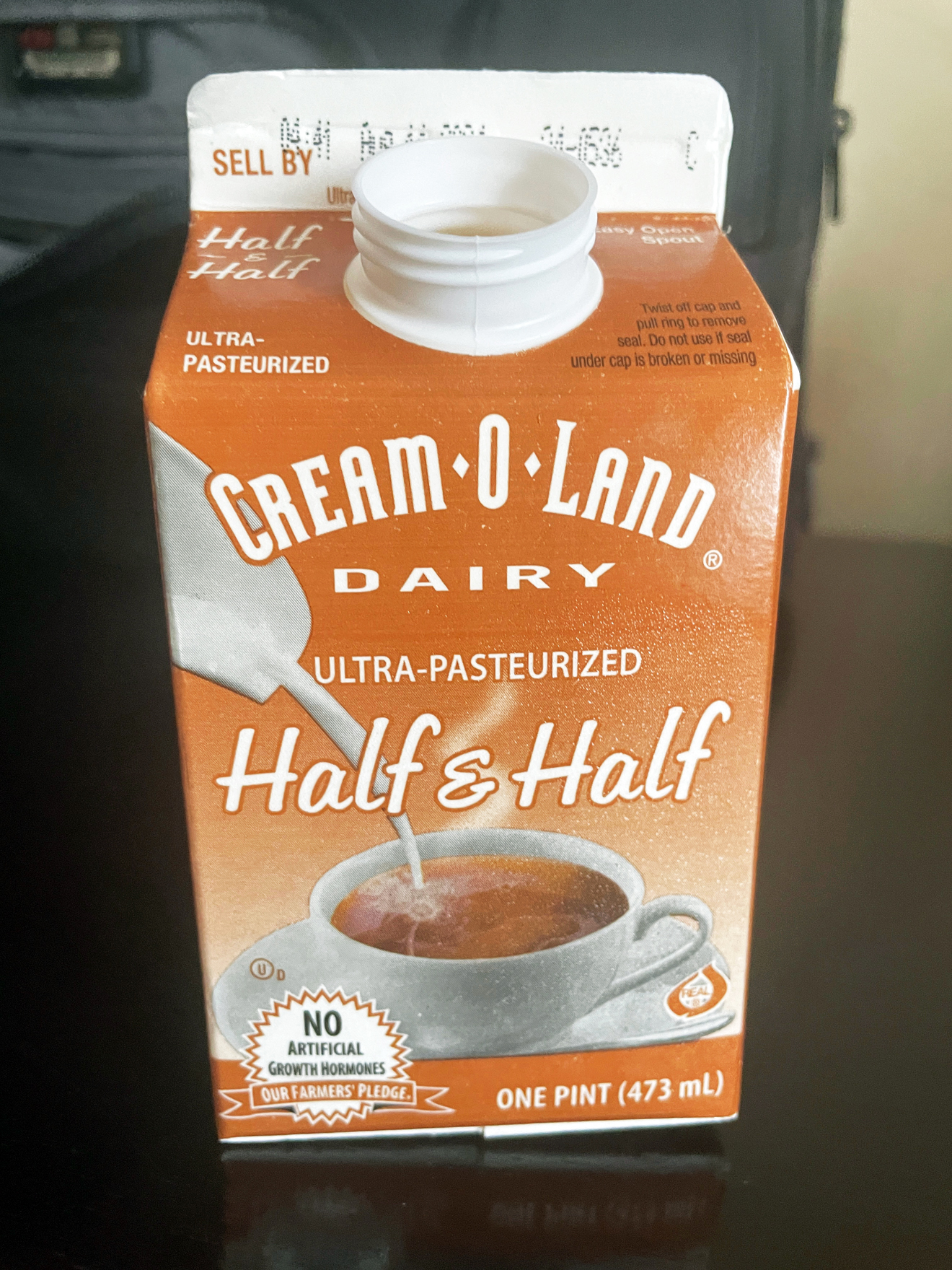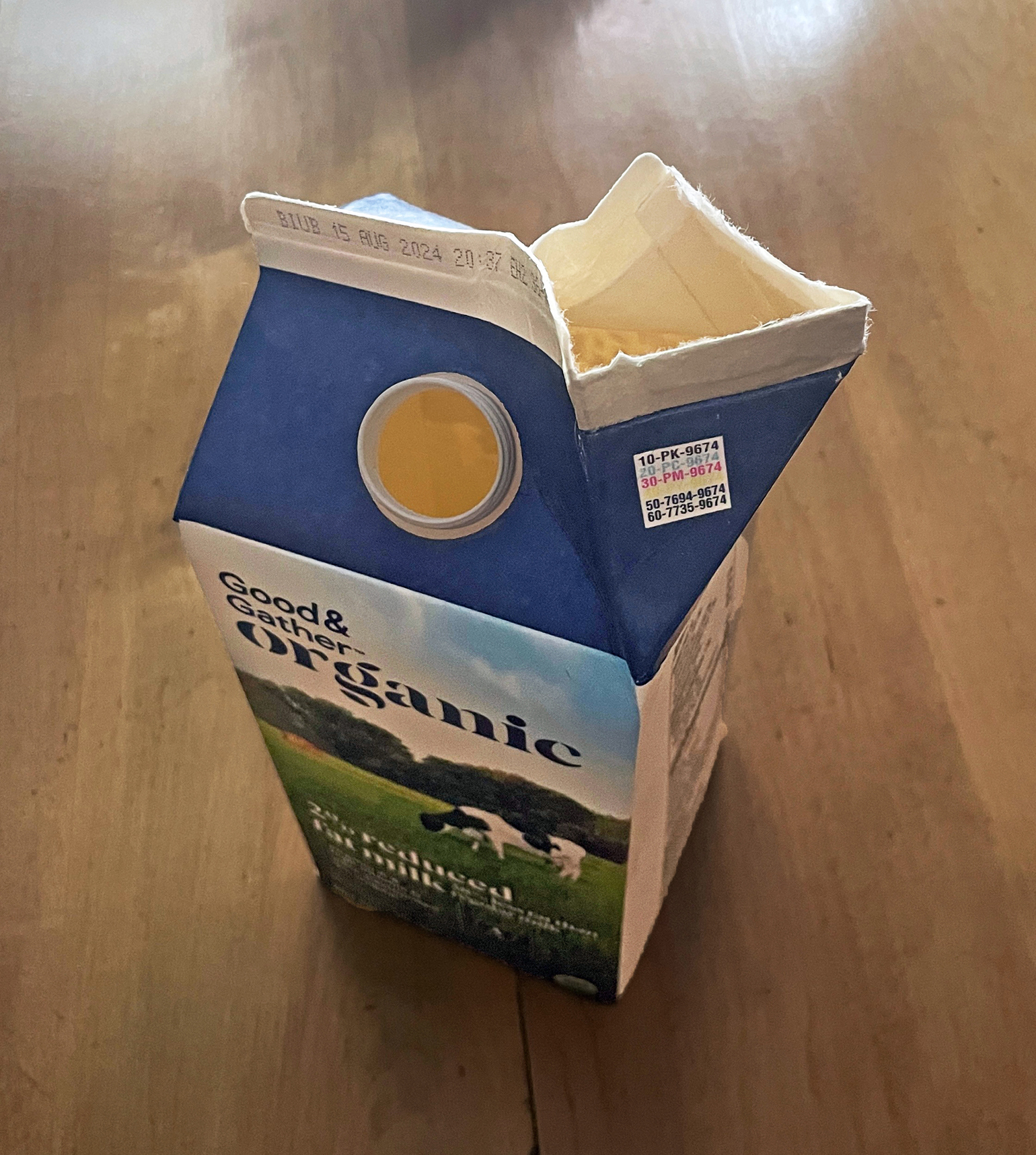Rise & Whine

July 18, 2024
DUBLIN, IRELAND
My custom is to set my alarm an hour or so earlier than our scheduled wake-up. For coffee and Instagram and such.
Having done so this morning, and now with nothing better to mull before the phone rings, it strikes that the name “Half & Half” is both redundant and meaningless.
If a product is half of something, then it’s automatically half of something else, no? A single percentage sum, by itself, should take care of it, obviating any need for a second one. This product should be called “Half.” (Which, admittedly, doesn’t carry much of a ring.)
Further, we ask, “Half & Half” of what, exactly? The name goes out of its way to overstate the obvious, yet fails to inform us what these respective halves consist of. Olive oil? Cranberry juice? Sand? Why the mystery? Indeed, as revealed in the picture above, and despite the kind assurance of ultra-pasteurization, the carton front displays no ingredients whatsoever.
Once again we find ourselves beguiled by the whims and foibles of corporate branding.
Now, in fairness to both mathematics and marketing, the second 50 percent of content could be easily diminished into additional fractions of whatever might compose it. The product could be half of one thing, but smaller amounts of multiple other things. Thus the name “Half & Two Quarters,” or some such.
This makes the whole conversation somewhat semantic (if less fun).
What we also see in the photograph, to our considerable dismay, is one of the more sadly devolved touches of modern carton manufacturing: the plastic screw top.
Those of us of a certain age remember the old-fashioned fold-back carton top. We miss the simplicity once employed to open, then quickly re-seal, a carton of milk or juice or “Half & Half.”
The choreography of the act was more complex than it looked, acquired through habit until performed without thinking, akin to tying one’s shoe: a tear, an unfolding, a bend, a squeeze.
The carton had no separate or moving parts. Rather, it was manipulated through a kind of muscle-memory origami. And when finished pouring, the resultant spout was, even more effortlessly, flipped back and restored to its original shape.
When did the transition to screw-tops begin? I want to say it was the early 1980s.
An inspirational debt is owed here to the author Nicholson Baker. Or vice-versa, perhaps, since this complaint was composed, at least in my head, before I’d read his wonderful book, The Mezzanine — the only other other place, to my knowledge, in which this subject is explored (page 42 in my edition). The book dates to 1986, which gives my timeline credence.
“The radiant idea that you tore apart one of the triangular eaves of the carton,” writes Baker, “using the stiffness of its own glued seam against itself.” The hand-formed, diamond-shaped opening was, “a better pourer than a circular bottle opening, because you could create a very fine stream of milk very simply.”
Indeed. The screw top, barbaric in comparison, with its jagged throw-away pull-ring and propensity to drip and splash, presumably provides more freshness, but at the cost of an almost magically elegant design.
Equal parts curiosity and nostalgia had me attempt the old-style maneuver at home, on the carton shown below. Results were mixed. The basics still work, but the molded circular collar now gets in the way. The adhesive seems different as well. The seams are no longer as tolerant to tearing, neither do they re-fold with as much authority.





Leave a Comment
Maximum 1500 characters. Watch your spelling and grammar. Poorly written posts will be deleted!
28 Responses to “Rise & Whine”
You are viewing newest comments first. Click to reverse order
For years now, when I’m feeling particularly careless, I spin this little comedic riff that goes something like:
“We sure are lucky that the recipe for half-and-half is what it is because if it wasn’t, we might find ourselves asking for two-sevenths and five-sevenths, or thirty-two percent and sixty-eight percent, or some such clumsy phrase.”
To my knowledge, no one has ever laughed at it and I don’t expect that to change here in this forum.
Love your writing. Been enjoying it since back in the Salon days. Cured myself of flight anxiety with your words.
These packages are called “consumer non-durables” and I used to work for a company that helped to design them. An *awful lot* of work goes into the design of these packages and the machines that make them and fill them. Focus groups, consumer testing, trial marketing. I had no idea.
Anyway, the screw top package has the advantage that it’s resealable. And the disadvantage that the first pour can catch you by surprise. Milk seems to last longer in the fridge when you can reseal the package. My advice is to get used to them, because, like those mail sorting machines during the previous administration, the machines that made the old style cartons are now perhaps brake cylinders or front fenders.
Patrick we enjoy receiving your informative pieces (sometimes in the Washington POST).
Keep us plugged in .
We’d also enjoy your visit if convenient. Jason and his family are very active. His daughter Bradyn (12 yo)was recruited for the US Olympic Development team. She’s working hard.
Stay safe and healthy.
Aunt Janet
What we also see in the photograph, to our considerable dismay, is one of the more sadly devolved touches of modern carton manufacturing: the plastic screw top.
The sadistic SOB who invented the plastic screw top should be taken out back and shot with a bullet made of frozen sour milk! I struggle to no end to get those caps on and off.
To see mention of Mr Baker’s AMAZING “The Mezzanine” fills me with joy today. 🙂
I’m not sure what the half is or the other half, but chances are it’s just six of one and a half-dozen of the other.
Timely article. I recently had this discussion with an American friend about the ubiquity of “strawberries and cream” in British life. The treat is sold at Wimbledon concession stands and in Tolkien’s “Lord of the Rings” Sam Gamgee confesses to yearning for strawberries and cream when he and Frodo are trapped on Mount Doom. My American friend had never heard of “strawberries and cream.” When I described “cream” he asked me if I meant “half and half” or “whole whipping cream.” He had never heard of just plain cream.
A survey of my local American supermarket shelf turned up products labeled half and half, whole whipping cream, lite whipping cream, non-dairy creamer, plant-based cream, sour cream, and “Crema Mexicana.” There doesn’t seem to be a product labeled as “cream.” Whole Foods sells a product called “Devon Clotted Cream” which features a British Union Jack on the label. Americans are familiar with the expressions “cookies and cream,” “peaches and cream,” “ice-cream,” and even describe things as being cream colored but they seem puzzled if you refer to dairy cream.
Growing up in Australia we had a jug of cream in our fridge. In America no one has heard of it.
Has that been your experience as well, Patrick? Is cream quintessentially English and unheard of on this side of the pond?
Cheers!
That screw top is a whole lot better than the tear -a-part spout if you want to put the container in your luggage/brief case if you want to use it later.
Welcome to Dublin, Patrick. Come back soon.
You must have brought your carton with you. I’d never heard of that stuff. I don’t remember when the plastic caps arrived here but I’m thinking that it was a lot more recent than the ‘80s as I well remember the original origami option. As has been mentioned elsewhere, we are at the forefront now of the latest version where the cap stays attached and causes all sorts of pouring fun. I’m surprised that no-one has yet suggested just removing the cap again altogether.
Dear Patrick
as your location is Dublin, you must have come across in your research the new screw top which remains attached to the collar of the container by a plastic ‘lash’. New too me anyway. Makes for an interesting juggle when pouring to keep the ‘top’ out of the flow. or when taking a ‘swig’ of the contents to keep the ‘top’ steady. A degree of dexterity now required to keep flow and receptacle apart.
If you are interested, Trader Joe’s still sells half & half in the old style carton:
https://www.fooducate.com/product/Trader-Joe-s-Organic-Half-Half/F18EDB00-3104-11E0-A55F-1231380C180E
They could just call it “half” but then you’d open and find it only half full and they say, “Hey, we warned you!”
But I do join the ranks of people who often hated the old spout because 1 out of 10 times the thing wouldn’t open like it should and your spout is now defective, too weak perhaps or even torn and then you’re stuck pouring badly for the rest of the container (which if it were “half”, wouldn’t be as long, at least)
The Dude knows that you always open it in the store and sniff for freshness before buying it.
https://www.youtube.com/watch?v=j1epEtB0lVo&t=90s
2:30
with that plastic cap, it is a LOT more work to compost the carton, too (where I live, milk cartons can go in the municipal composting). It can be removed but it’s a pain.
Hey Patrick,
Sure – but “Half & Half” means “half milk and half cream” so you know you aren’t getting half cream and half whatever else they want to throw in there…
And I’d think that you might want the screw top so you can take it with you without spilling it?
No?
I love this kind of stuff…
Kroger, at least, puts “Milk and Cream” or “Cream and Milk” on the face of its Half & Half containers too lazy to get up and look at the moment), so I know I’m not getting Milk and Tapioca Pudding.
Patrick,
You must have had some time in your hands this morning… enough to create this very clever post that I’m enjoying as I cross the country slowly on the California Zephyr (formerly the San Francisco Zephyr.)
Thanks for making me smile about ‘half and half’ while I take in the vastness of the Iowa corn fields. Gail
Here in my part of Canada we don’t have Half & Half. What we have instead is 10% (which, if you do the math correctly, is 90% milk) and delicious in coffee. We also have 35% which whips nicely into whipped cream or makes wonderful ice cream.
The most puzzling issue raised by the name “Half & Half” is that the second Half (presumably whole milk) will have a cream component too & that to arrive at the true percentage requires adding 50 plus … what? And where does that leave us?
And yes, with the old fold-back design you could get a fine stream, but there remained the risk that on one side you’d unwittingly open out a layer or two too many or too few, with the result that you’d end up pouring the stuff not into your cup but onto one of your knees.
Don’t know about yours, but my curmudgeonly mind can think of many dozens of things that our civilization has made exasperatingly “more convenient” for us.
And yet I think that most of us knew half what and half what.
Half cream and half milk. Although I doubt that the producer actually mixed milk and cream. Instead, when it came time to take the fat off the whole milk (4% milkfat), the workers (or the machines) simply took off only part of the fat. Or maybe they skimmed all the fat off one container of milk (leaving nonfat/skim milk),then added it to another container that still had its original 4%. Which, I’d guess, depends on the relative demand for skim vs. reduced-fat milk vs. cream vs.half-and-half.
the real problem with the plastic screwtop is that it makes the package what William McDonough called a “monstrous hybrid” that is not recyclable since you cannot separate the plastic from the paper. All for a little bit of silly convenience that was built into the traditional top.
Ah, not so fond memories of the diamond of death. As an elementary student in the mid 1960s, my motor skills were far below the norm. Opening those damn milk cartons, along with ever collapsing paper straws, made lunch time a daily challenge. Happy as hell when our school switched to cartons with paper pull tops
I’m surprised that in Ireland, such a carton is still allowed (because of EU labelling laws).
It is confusing to people from other cultures, especially if none of the sides have a full content list or explanation.
I looked on wikipedia to figure out what exactly the other “half” was, and got confused (before I looked further)
“”Half and half” or “Half-and-half” is a mixture of milk and cream, which is often used in coffee and with breakfast cereals. … In the United States, half-and-half must contain between 10.5 and 18 percent milkfat.”
I was used to cream (for whipping) having 30% fat, but that’s a legal definition, not what you get from skimming the cream off the milk. Cream can be sold in different percentage of fat, so what is called half-and-half in English is mostly equivalent to Kaffeesahne (coffe cream).
But it would make things easier to write “Half Milk, Half Cream” and the fat percentage right on the package.
When I buy normal milk, the fat percentage (normal, 3.5%, or reduced, 1.5% or even less) is written in big numbers underneath the word milk so people can easily see it. I think that’s helpful.
Oh good, I was halfway through this post thinking “this guy has to read The Mezzanine” and then you mentioned it. I think my favorite bit is the excruciating anatomy of meeting a colleague in the men’s room.
Were it merely “half” that would immediately beg the question[1] of what the other half was. (Though, yes, I definitely prefer something that also explains what the halves are, i.e. semi-skimmed).
I’m all for the plastic screw tops too (though where I am they tend to come without the extra pull piece thankfully). One less hassle, one less chance to ruin your day by messing up your ripping, and the seal feels a lot more reliable. And it’s not exactly hard to pour a precise amount out – it’s no different from using a regular plastic bottle after all.
[1] Yes I’m aware that many dictionaries carry outdated definitions of this phrase
I hate the plastic screw tops. Aside from the difficulty of tearing out the little throwaway plastic piece, the spout gets in the way of properly crushing the carton before throwing it in the trash, plus, it’s awkward holding the carton to pour when the seam is perpendicular to your hand instead of in line with your hand. Furthermore, it’s really hard to drink out of the carton through the screw cap spout.
Until a few years ago, one of the dairies in the Pacific Northwest still sold milk in the old style folding spout. I became a regular buyer of that brand for the simple reason that they were the only brand that still had the folding spout. Then, one day, maybe 5-7 years ago, they stopped. I wrote several letters complaining, but only got the usual corporate nonsense in response. I tried opening the cartons the old way, but the new adhesive made it impossible to drink from the resulting spout – it was too flimsy.
It could even be half and half of the same thing. A carton of all milk IS half milk and half milk, so anything could really be half and half.
Or, what if the carton isn’t filled all the way at the factory (the way bags of chips seem to be mostly air these days). Then it could be Quarter and Quarter (which is when the carton is Half filled of Half and Half, in that case three Halfs don’t even make a Whole).
Or…what if the milk is 2% milk, and the cream is 100%. Then it’s (0.5*.02 = 0.01) and (0.5*1 = 0.5) so it’s “Hundredth and Half”.
Also, once at KFLL, at a coffee shop, they had those little tiny containers of cream that didn’t need to be refrigerated where you peel the top. They had two bins, one of them had the containers of half and half, and another (kid you not) had ones that said “Non Dairy Creamer. Contains milk.”
Thanks for this! I do remember messing up the carton though and not being able to form a strong spout. And the screw top is easier for children to manage, I think. The real mystery is why manufacturers boast that their buttermilk has real particles of butter.